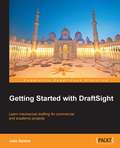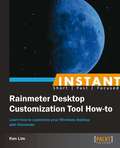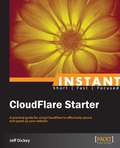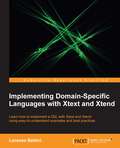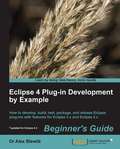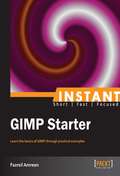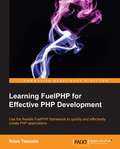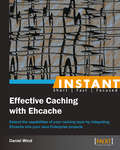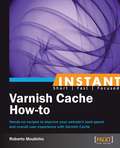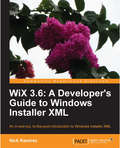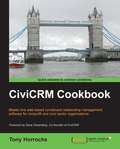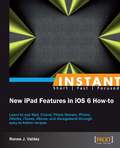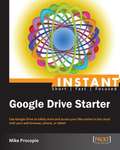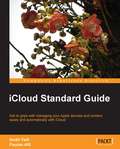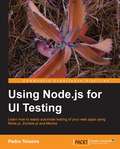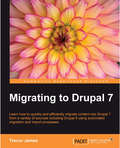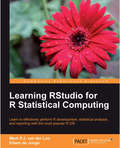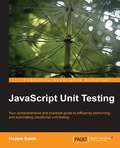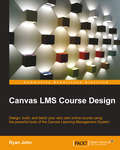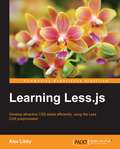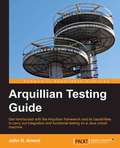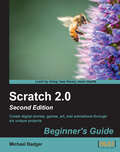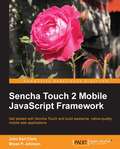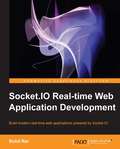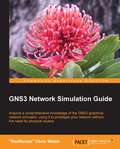- Table View
- List View
Getting Started with DraftSight
by Joao SantosPacked with illustrations and step-by-step guidelines, this book will serve as a guide for DraftSight and get you up and running with it!Getting Started withDraftSightis for anyyone who wants to create accurate 2D drawings in the DWG file format. It is also a great resource for architectural, engineering, or design professionals and students. The reader needs to have basic knowledge of CAD.
Instant Rainmeter Desktop Customization Tool How-to
by Ken LimFilled with practical, step-by-step instructions and clear explanations for the most important and useful tasks. A short, concise book focused on delivering immediate results with practical recipes on customizing your desktop.This book is geared towards PC users with sufficient working knowledge of Windows. You should be comfortable with surfing the Web, and downloading and manipulating files on your desktop to start with. We will provide you with the rest.
Instant CloudFlare Starter
by Jeff DickeyWritten as a practical guide, CloudFlare Starter will show you all you need to know in order to effectively improve your online presence in a multitude of different ways."CloudFlare Starter" is a practical yet accessible guide for website owners looking to optimize their site for optimum security and maximum performance.
Implementing Domain-Specific Languages with Xtext and Xtend
by Lorenzo BettiniA step-by-step guide that enables you to quickly implement a DSL with Xtext and Xtend in a test-driven way with the aid of simplified examples.This book is for programmers who want to learn about Xtext and how to use it to implement a DSL (or a programming language) together with Eclipse IDE tooling. It assumes that the user is familiar with Eclipse and its functionality. Existing basic knowledge of a compiler implementation would be useful, though not strictly required, since the book will explain all the stages of the development of a DSL.
Eclipse 4 Plug-in Development by Example Beginner's Guide
by Dr Alex BlewittA Beginner's Guide following the "by Example" approach. There will be 5-8 major examples that will be used in the book to develop advanced plugins with the Eclipse IDE.This book is for Java developers who are familiar with Eclipse as a Java IDE and are interested in learning how to develop plug-ins for Eclipse. No prior knowledge of Eclipse plug-in development or OSGi is necessary, although you are expected to know how to create, run, and debug Java programs in Eclipse.
Instant GIMP Starter
by Fazreil AmreenA Starter guide which helps you practically start with GIMP through plenty of examples and screenshots. This is an excellent handbook for anyone who would like to start drawing using their computers. The approach used within this book is objective so that readers from any age will be able to learn the process. The setup is so basic that you will need only a computer and a very minimal amount of computer literacy to start using this book.
Learning FuelPHP for Effective PHP Development
by Ross TweedieThe book follows a standard tutorial approach, which will enable readers to use the FuelPHP framework efficiently while developing PHP applications.If you are a PHP developer who is looking to learn more about using the FuelPHP framework for effective PHP development, this book is ideal for you. If you are interested in this book, you should already have a basic understanding of general PHP development.
Instant Effective Caching with Ehcache
by Daniel WindFilled with practical, step-by-step instructions and clear explanations for the most important and useful tasks. This is a Packt How-to containing hands-on recipes that discuss integrating Ehcache into your Java application.This book is aimed at Java developers who are looking for an Ehcache integration reference guide and want to get a good background in its fundamental core functionality. It is assumed that you have some experience with Java. Prior knowledge in Ehcache is not a requirement.
Instant Varnish Cache How-to
by Roberto MoutinhoFilled with practical, step-by-step instructions and clear explanations for the most important and useful tasks. Get the job done and learn as you go. Easy-to-follow, step-by-step recipes which will get you started with Varnish Cache. Practical examples will help you to get set up quickly and easily.This book is aimed at system administrators and web developers who need to scale websites without tossing money on a large and costly infrastructure. It's assumed that you have some knowledge of the HTTP protocol, how browsers and server communicate with each other, and basic Linux systems.
WiX 3.6: A Developer's Guide to Windows Installer XML
by Nick RamirezA step-by-step tutorial with plenty of code and examples to improve your learning curve. If you are a developer and want to create installers for software targeting the Windows platform, then this book is for you. You'll be using plenty of XML and ought to know the basics of writing a well-formed document. No prior experience in WiX or Windows Installer is assumed. You should know your way around Visual Studio to compile projects, add project references and tweak project properties.
CiviCRM Cookbook
by Tony HorrocksThis book is written in cookbook style with practical, comprehensive recipes expained with the aid of the necessary screenshots.If you have basic CiviCRM skills and want to further enhance your CiviCRM skills, this book is for you.
Instant New iPad Features in iOS 6 How-to
by Renee J. ValdezA how-To book with practical recipes accompanied with rich screenshots for easy comprehension. "The New iPad: Using New Features in iOS 6 How-To" is for anyone somewhat familiar with an iPad but wanting to get an overview of its new features. A basic understanding of touch devices is good but not necessary. The recipes walk you through everything you need to know to accomplish each task. Good for the novice and the expert, there's something in here for everyone.
Instant Google Drive Starter
by Mike ProcopioThis book is a Starter which teaches you how to use Google Drive practically. This book is perfect for people of all skill levels who want to enjoy the benefits of using Google Drive to safely store their files online and in the cloud. It's also great for anyone looking to learn more about cloud computing in general. Readers are expected to have an Internet connection and basic knowledge of using the internet.
iCloud Standard Guide
by Andri Yadi Fauzan AlfiAn easy-to-use guide, filled with tutorials that will teach you how to set up and use iCloud, and profit from all of its marvellous features.This book is for anyone with basic knowledge of computers and mobile operations. Prior knowledge of cloud computing or iCloud is not expected.
Using Node.js for UI Testing
by Pedro TeixeiraFull of techniques and tips for simulating user interactions and verifying that your application is behaving correctly.This book is for frontend and backend web application developers that know how to program in JavaScript.
Migrating to Drupal
by Trevor JamesWritten in a friendly and engaging style with practical tutorials and step-by-step examples which show you how to easily migrate your Drupal 6 or WordPress site to Drupal 7. "Drupal 7: A Guide to Migration" is for anyone interested in how to move content from an existing website into the Drupal content management system. Both novice and advanced Drupal users will gain practical hands-on knowledge in how to migrate content into Drupal using this book. You will become experts in using the Feeds module to migrate content, and in packaging your code using Features.
Learning RStudio for R Statistical Computing
by Edwin De Jonge Mark Van LooA practical tutorial covering how to leverage RStudio functionality to effectively perform R Development, analysis, and reporting with RStudio. The book is aimed at R developers and analysts who wish to do R statistical development while taking advantage of RStudio functionality to ease their development efforts. Familiarity with R is assumed. Those who want to get started with R development using RStudio will also find the book useful. Even if you already use R but want to create reproducible statistical analysis projects or extend R with self-written packages, this book shows how to quickly achieve this using RStudio.
JavaScript Unit Testing
by Hazem SalehA practical, example-driven guide to using, automating, and integrating JavaScript Unit tests for the busy and conscientious JavaScript developer striving for excellence and success. JavaScript Unit Testing is a must have guide for every web developer, designer, architect, and JavaScript coder seeking to ensure the highest quality of their web applications and JS code. Knowledge of JavaScript is assumed.
Canvas LMS Course Design
by Ryan JohnThis book is intended for educators who want to use Canvas to enhance their teaching or for educators whose institution has adopted Canvas as its learning management system. Whether you are brand new to online learning or you are a seasoned expert, you will be able to master both the basic functions and the advanced features of Canvas with this book.
Learning Less.js
by Alex LibbyIf you are a designer or developer who wants to quickly learn how to harness the power of Less.js to write more efficient CSS styles that can be applied to a website of any size, then this book is for you. This book will help you master both the basic functions and advanced features of Less.js. It would be helpful to have some familiarity of writing CSS styles, although no prior experience of using CSS preprocessors is required.
Arquillian Testing Guide
by John D. AmentThis book is a tutorial filled with plenty of code examples and strategies to give you many options when building your test structure.This book is for developers and testers alike. Anyone who has worked with test driven development or building automated test cases will find use in this book. A reader should be familiar with some automation strategies and techniques such as JUnit and should have some exposure to techniques such as mocking.
Scratch 2.0 Beginner's Guide Second Edition
by Michael BadgerThe book uses step-by-step instructions along with full code listings for each exercise. After each exercise, the author pauses to reflect, explain, and offer insights before building on the project. The author approaches the content with the belief that we are all teachers and that you are reading this book not only because you want to learn, but because you want to share your knowledge with others. Motivated students can pick up this book and teach themselves how to program because the book takes a simple, strategic, and structured approach to learning Scratch. Parents can grasp the fundamentals so that they can guide their children through introductory Scratch programming exercises. It's perfect for homeschool families. Teachers of all disciplines from computer science to English can quickly get up to speed with Scratch and adapt the projects for use in the classroom.
Sencha Touch 2 Mobile JavaScript Framework
by Bryan P. Johnson John Earl ClarkFull of explained code and enriched with screenshots, this book is the practical way to take your Sencha Touch skills to the next level.If you want to gain practical knowledge for using the Sencha Touch mobile web application framework, and you are familiar with HTML and CSS, then this book is for you. It is assumed that you know how to use touchscreens, touch events, and mobile devices such as Apple iOS and Google Android.
Socket.io Real-time Web Application Development
by Rohit RaiWritten in an engaging, easy-to-follow style, "Socket.io Real-time Web Application Development" is a practical guide for developing real-time web applications with Node.js and socket.io.This book is aimed at developers who want to start developing highly interactive and real-time web applications like chat systems or online multiplayer games, or want to introduce real-time updates or server push mechanisms in their existing applications. Knowledge of developing in JavaScript and web applications in general is expected. Though there is a chapter on introducing Node.js, prior knowledge of Node.js will be a plus.
GNS3 Network Simulation Guide
by Rednectar" Chris WelshGNS3 Network Simulation Guide is an easy-to-follow yet comprehensive guide which is written in a tutorial format helping you grasp all the things you need for accomplishing your certification or simulation goal. If you are a networking professional who wants to learn how to simulate networks using GNS3, this book is ideal for you. The introductory examples within the book only require minimal networking knowledge, but as the book progresses onto more advanced topics, users will require knowledge of TCP/IP and routing.
